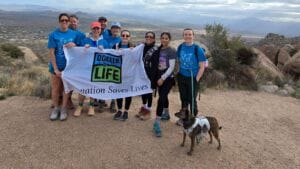Metro Phoenix is currently the single location in the U..S most susceptible to a large, sustained measles outbreak. I don’t make that assertion lightly.
You’ve probably heard about recent measles outbreaks in the news. As of this writing, 7 cases in Texas, 53 cases in Washington State, 204 cases in New York, and a phenomenal 80,000 cases last year in Europe, including some 50,000 hospitalizations and at least 72 deaths. Measles is a vaccine preventable disease that was uncommon in most of the developed world until recent years, and declared “eliminated” from the Western Hemisphere only a few years ago.
What’s going on here?
No vaccine is perfect, but the measles component of the MMR vaccine is about as close as we come. Two doses of measles vaccine, the first at 12-15 months of age and the second between 4 and 6 years of age, offers about 97% protection. That means that if a vaccinated person is directly exposed to the measles virus, there is only a 3% chance that he or she will become infected. Even if a person with measles walks amongst us, as long as nearly everyone is vaccinated, it is much harder for the virus to find another person to infect. And if it does find another person or two to make ill, it is hard for it to spread any further.
That’s called “herd immunity,” and that’s what really keeps outbreaks from happening. Each of us will likely never know whether our own vaccine worked to protect us, because we’ll never be exposed in the first place. Herd immunity greatly amplifies the effect of vaccines, and in fact provides protection even for those who cannot be vaccinated, such as immunosuppressed cancer patients, or infants too young to get their first dose of vaccine.
Because of herd immunity, measles, a disease which once infected a half million Americans each year, mostly children, and killed several hundred annually, became virtually unknown in this country – until recently.
Increasing rates of parental refusal to vaccinate their kids, often based upon misrepresentations in social media, has led to lower rates of immunization in children both in Europe and in the US. It appears from the European experience and elsewhere that a community-wide immunization rate of 95% is the approximate threshold for maintaining herd immunity against measles. Statewide, we’ve slipped just below that, and still falling. But Maricopa County is particularly vulnerable.
Arizona is one of only 17 states that allow parents to claim “personal beliefs” exemptions for school required immunizations. Our rate of these non-medical exemptions has been steadily growing. There are many schools within our community, particularly some charter schools, which have kindergarten immunization rates of 50% or lower. If a case of measles entered any of those schools, there would be an explosive outbreak. That much we know for sure.
But worse, and more fearful, is the possibility that if that happens, a sustained community outbreak could result in metro Phoenix. Such an outbreak would be fueled not just by the low rate of immunization occurring in small pockets in certain schools, but by the total number of susceptible children (and adults) within the broader community.
At 4.3 million people, Maricopa County is huge. As it turns out, when you multiply our immunization exemption rate by the total number of kindergarten school children, we have the largest number of exempted kindergarten kids in the country. A recent study did just that, and found that we have more than triple the number of these susceptible children than the next closest community – nearly 3,000 compared to less than 1,000 in Salt Lake City. (The state of the antivaccine movement in the United States: A focused examination of nonmedical exemptions in states and counties. Olive, JK, et al., PLOS Med, J PMed. June 12, 2018)
Here’s the point. If a single measles case lands in one of our severely under-immunized schools, causing a localized outbreak within that school, there will be several new cases, leading to ample opportunity for it to spread further. Given our large population of unimmunized kids, we may be at greater risk for experiencing a truly large, community-wide outbreak than any other place in the US. If that comes, and our lack of herd immunity causes an outbreak in which many of us are exposed, even some of those who have been immunized will get sick (remember, fully vaccinated persons are only 97% protected, so 3% of those exposed will probably become ill despite their own vaccine). Think about that.
And it won’t come cheap. Because it is so wildly infectious, measles outbreaks are the most intense and expensive outbreaks that public health departments and the medical community generally face. The public cost alone to Maricopa County of just two cases in recent years was more than $120,000. (Cost Analysis of 3 Concurrent Public Health Response Events: Financial Impact of Measles Outbreak, Super Bowl Surveillance, and Ebola Surveillance in Maricopa County. McCullough, JM, et al., Journal of Public Health Management and Practice: June 20, 2018.) A major outbreak leading to hundreds of cases, as seen in Europe, will cost this community many millions of dollars.
Herd immunity is nothing short of a medical miracle. What truly protects you right now is not so much the vaccine you got as the vaccines that everyone around you got. And being immunized, and immunizing your children, doesn’t just protect you. It helps protect the entire community, including those most vulnerable.
Nothing screams that we’re all in this life together quite like the miracle of herd immunity. And nothing will demonstrate just how foolish we are as a society like a needless, major measles epidemic more than half a century after the development of a safe and effective vaccine.
Bob England, MD, MPH is




